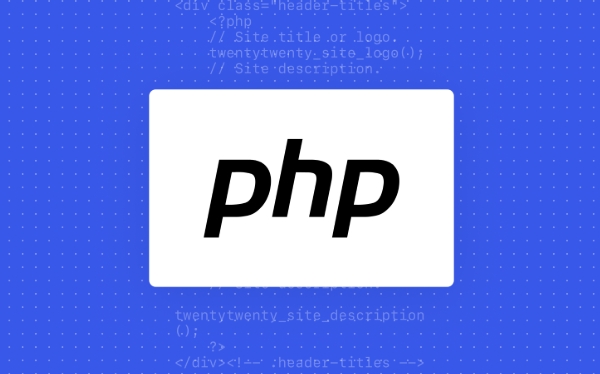How to get a string between two other strings in PHP
Jul 13, 2025 am 02:20 AMTo extract content from between two strings, you can use PHP's strpos() and substr() functions to implement it. First, find the position of the starting mark and calculate its end point, then find the starting position of the end mark, and finally use substr() to intercept the intermediate content. 1. Use strpos() to locate the starting mark position, and return an empty string if not found; 2. Calculate the actual starting position after the starting mark; 3. Use strpos() to search for the end mark position from the starting position, and return an empty string if not found; 4. Extract the content of the specified range through substr(). For complex scenarios such as multi-match or nested tags, consider the regular expressions preg_match() or preg_match_all(), where non-greedy patterns.? ensure that the most recent end tag is matched, and the /s modifier supports cross-row matching. Recommended DOM parsing tools when processing HTML or structured data. Be careful to avoid common errors: make sure case matching, handle missing tags, support multibyte character encoding using the mb_ function, and always add error checking logic to enhance code robustness.

To get a string between two other strings in PHP, you can use a combination of string functions like strpos() , substr() , and some basic logic. It's not built-in as a single function, but it's straightforward once you understand how to find the starting and ending positions of the part you want.

Find the content between two markers
Let's say you have a string like this:
$text = "This is some example text with [start]important data[end] inside.";
And you want to extract whatever is between [start] and [end] . Here's how to do it:

- Find where
[start]ends — that's your starting point. - Find where
[end]begins — that's your endpoint. - Use
substr()to pull out the part in between.
Here's a basic function:
function getStringBetween($text, $start, $end) {
$startPos = strpos($text, $start);
if ($startPos === false) return '';
$startPos = strlen($start);
$endPos = strpos($text, $end, $startPos);
if ($endPos === false) return '';
return substr($text, $startPos, $endPos - $startPos);
}You'd call it like:

$result = getStringBetween($text, '[start]', '[end]'); echo $result; // Outputs: important data
This works well for simple cases and avoids unnecessary complexity.
Handle multiple occurences or nested markers
If your input might contain more than one match (like multiple [start]...[end] blocks), or if there's a chance of nested markers, the above approach may not work perfectly.
In those situations, consider using regular expressions with preg_match() or preg_match_all() .
For example:
preg_match('/$start$(.*?)$end$/s', $text, $match); echo isset($match[1]) ? $match[1] : '';
The .*? makes it non-greedy, so it stops at the first [end] . The /s modifier allows the dot ( . ) to match newlines too, which is handy if your content spans multiple lines.
If you're dealing with HTML or structured data, parsing with DOM or XML tools would be better than regex — but for plain text, regex is often good enough.
Watch out for edge cases
There are a few things that can trip you up:
- Case sensitivity: Make sure your start/end strings exactly match in case unless you normalize both the input and search strings.
- Overlapping markers: If your end marker overlas with another occurrence, it can break the extraction.
- Missing markers: Always check if
strpos()returnsfalsebefore doing math on it — otherwise you'll get negative positions or errors. - Encoding issues: If you're working with multibyte characters (eg, UTF-8), use
mb_*functions instead of standard ones to avoid cutting characters in half.
So, when writing your code, always include error checks and fallbacks:
- Check if the start and end strings exist in the text.
- Avoid assuming that every
[start]has a matching[end]. - Don't hardcode values — make your function flexible enough to reuse.
Basically that's it. It's not complicated, but easy to mess up if you skip validation.
The above is the detailed content of How to get a string between two other strings in PHP. For more information, please follow other related articles on the PHP Chinese website!

Hot AI Tools

Undress AI Tool
Undress images for free

Undresser.AI Undress
AI-powered app for creating realistic nude photos

AI Clothes Remover
Online AI tool for removing clothes from photos.

Clothoff.io
AI clothes remover

Video Face Swap
Swap faces in any video effortlessly with our completely free AI face swap tool!

Hot Article

Hot Tools

Notepad++7.3.1
Easy-to-use and free code editor

SublimeText3 Chinese version
Chinese version, very easy to use

Zend Studio 13.0.1
Powerful PHP integrated development environment

Dreamweaver CS6
Visual web development tools

SublimeText3 Mac version
God-level code editing software (SublimeText3)

Hot Topics
 How to use PHP to build social sharing functions PHP sharing interface integration practice
Jul 25, 2025 pm 08:51 PM
How to use PHP to build social sharing functions PHP sharing interface integration practice
Jul 25, 2025 pm 08:51 PM
The core method of building social sharing functions in PHP is to dynamically generate sharing links that meet the requirements of each platform. 1. First get the current page or specified URL and article information; 2. Use urlencode to encode the parameters; 3. Splice and generate sharing links according to the protocols of each platform; 4. Display links on the front end for users to click and share; 5. Dynamically generate OG tags on the page to optimize sharing content display; 6. Be sure to escape user input to prevent XSS attacks. This method does not require complex authentication, has low maintenance costs, and is suitable for most content sharing needs.
 How to use PHP combined with AI to achieve text error correction PHP syntax detection and optimization
Jul 25, 2025 pm 08:57 PM
How to use PHP combined with AI to achieve text error correction PHP syntax detection and optimization
Jul 25, 2025 pm 08:57 PM
To realize text error correction and syntax optimization with AI, you need to follow the following steps: 1. Select a suitable AI model or API, such as Baidu, Tencent API or open source NLP library; 2. Call the API through PHP's curl or Guzzle and process the return results; 3. Display error correction information in the application and allow users to choose whether to adopt it; 4. Use php-l and PHP_CodeSniffer for syntax detection and code optimization; 5. Continuously collect feedback and update the model or rules to improve the effect. When choosing AIAPI, focus on evaluating accuracy, response speed, price and support for PHP. Code optimization should follow PSR specifications, use cache reasonably, avoid circular queries, review code regularly, and use X
 PHP creates a blog comment system to monetize PHP comment review and anti-brush strategy
Jul 25, 2025 pm 08:27 PM
PHP creates a blog comment system to monetize PHP comment review and anti-brush strategy
Jul 25, 2025 pm 08:27 PM
1. Maximizing the commercial value of the comment system requires combining native advertising precise delivery, user paid value-added services (such as uploading pictures, top-up comments), influence incentive mechanism based on comment quality, and compliance anonymous data insight monetization; 2. The audit strategy should adopt a combination of pre-audit dynamic keyword filtering and user reporting mechanisms, supplemented by comment quality rating to achieve content hierarchical exposure; 3. Anti-brushing requires the construction of multi-layer defense: reCAPTCHAv3 sensorless verification, Honeypot honeypot field recognition robot, IP and timestamp frequency limit prevents watering, and content pattern recognition marks suspicious comments, and continuously iterate to deal with attacks.
 PHP calls AI intelligent voice assistant PHP voice interaction system construction
Jul 25, 2025 pm 08:45 PM
PHP calls AI intelligent voice assistant PHP voice interaction system construction
Jul 25, 2025 pm 08:45 PM
User voice input is captured and sent to the PHP backend through the MediaRecorder API of the front-end JavaScript; 2. PHP saves the audio as a temporary file and calls STTAPI (such as Google or Baidu voice recognition) to convert it into text; 3. PHP sends the text to an AI service (such as OpenAIGPT) to obtain intelligent reply; 4. PHP then calls TTSAPI (such as Baidu or Google voice synthesis) to convert the reply to a voice file; 5. PHP streams the voice file back to the front-end to play, completing interaction. The entire process is dominated by PHP to ensure seamless connection between all links.
 How to use PHP to combine AI to generate image. PHP automatically generates art works
Jul 25, 2025 pm 07:21 PM
How to use PHP to combine AI to generate image. PHP automatically generates art works
Jul 25, 2025 pm 07:21 PM
PHP does not directly perform AI image processing, but integrates through APIs, because it is good at web development rather than computing-intensive tasks. API integration can achieve professional division of labor, reduce costs, and improve efficiency; 2. Integrating key technologies include using Guzzle or cURL to send HTTP requests, JSON data encoding and decoding, API key security authentication, asynchronous queue processing time-consuming tasks, robust error handling and retry mechanism, image storage and display; 3. Common challenges include API cost out of control, uncontrollable generation results, poor user experience, security risks and difficult data management. The response strategies are setting user quotas and caches, providing propt guidance and multi-picture selection, asynchronous notifications and progress prompts, key environment variable storage and content audit, and cloud storage.
 PHP realizes commodity inventory management and monetization PHP inventory synchronization and alarm mechanism
Jul 25, 2025 pm 08:30 PM
PHP realizes commodity inventory management and monetization PHP inventory synchronization and alarm mechanism
Jul 25, 2025 pm 08:30 PM
PHP ensures inventory deduction atomicity through database transactions and FORUPDATE row locks to prevent high concurrent overselling; 2. Multi-platform inventory consistency depends on centralized management and event-driven synchronization, combining API/Webhook notifications and message queues to ensure reliable data transmission; 3. The alarm mechanism should set low inventory, zero/negative inventory, unsalable sales, replenishment cycles and abnormal fluctuations strategies in different scenarios, and select DingTalk, SMS or Email Responsible Persons according to the urgency, and the alarm information must be complete and clear to achieve business adaptation and rapid response.
 Beyond the LAMP Stack: PHP's Role in Modern Enterprise Architecture
Jul 27, 2025 am 04:31 AM
Beyond the LAMP Stack: PHP's Role in Modern Enterprise Architecture
Jul 27, 2025 am 04:31 AM
PHPisstillrelevantinmodernenterpriseenvironments.1.ModernPHP(7.xand8.x)offersperformancegains,stricttyping,JITcompilation,andmodernsyntax,makingitsuitableforlarge-scaleapplications.2.PHPintegrateseffectivelyinhybridarchitectures,servingasanAPIgateway
 PHP integrated AI speech recognition and translator PHP meeting record automatic generation solution
Jul 25, 2025 pm 07:06 PM
PHP integrated AI speech recognition and translator PHP meeting record automatic generation solution
Jul 25, 2025 pm 07:06 PM
Select the appropriate AI voice recognition service and integrate PHPSDK; 2. Use PHP to call ffmpeg to convert recordings into API-required formats (such as wav); 3. Upload files to cloud storage and call API asynchronous recognition; 4. Analyze JSON results and organize text using NLP technology; 5. Generate Word or Markdown documents to complete the automation of meeting records. The entire process needs to ensure data encryption, access control and compliance to ensure privacy and security.






